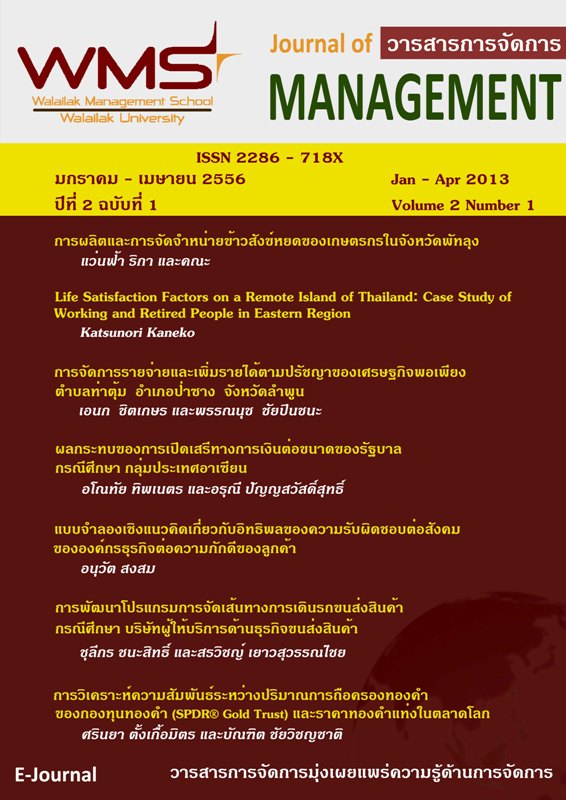The Effect of Financial Liberalization on Government Size: A Case of ASEAN
Main Article Content
Abstract
This study is about the effect of financial liberalization on government size in the case of ASEAN countries. The objectives of the study are: to consider the overall government size, the degree of financial liberalization and to examine the effect of financial liberalization on government size in the case of ASEAN countries. This research based on Erauskin (2010) s’ work which employed Portfolio Approach. These are base on the secondary data, panel data including 3 countries in ASEAN countries which are Malaysia, Singapore and Thailand since the annual data during 1975-2005. The quantitative analysis such as Panel Unit Root Test and Panel Model, both Fixed Effects Model and Random Effects Model, are used in this research. The result of the research showed that the change in financial liberalization that measures from De Facto, the change in ratio of real government revenue to wealth, and the change in degree of openness have positive effect on the change in government size. However, the result found that the financial liberalization that measures from De Jure method did not affect the change in government size. In conclusion, the financial liberalization policy should be conducted with cautious and appropriate.
Article Details
References
เทียนทิพ สุพานิช และเรจินา วรอุไร. 2544. นโยบายการเปิดเสรีทางการเงิน: สู่แนวคิดใหม่. วารสารบทความวิชาการธนาคารแห่งประเทศไทย. กรกฎาคม (2544), 3-5.
อรัญ ธรรมโน. 2548. ความรู้ทั่วไปทางการคลัง. (พิมพ์ครั้งที่ 1). กรุงเทพมหานคร: อมรินทร์พริ้นติ้งแอนด์พับลิชชิ่ง.
Abaid A,.Detragiache E, Tressel T. 2008. A New Database of Financial Reforms. IMF Working Paper. 266.
Cameron, David R. 1978. “The Expansion of the Public Economy”, American Political Science Review, 72, 1243-1261
Chinn Menzie and Ito Hiro. 2011. The Chinn-Ito Index: A De Jure Measure of Financial Openness [Online]. available: http://web.pdx.edu/~ito/Chinn-Ito_website.htm.
Erauskin Inaki. 2010. Financial Openness and the Size of the Public sector: a Portfolio Apprach. University of Deusto-ESTE. (Mimeographed).
Kaminsky G. Laura and Sergio L. Schmukler. 2003. Short-Run Pain, Long-Run Gain: The Effects of Financial Liberalization. IMF Working Paper, 03/34.
Kimakova Alena. 2009. Government Size and Openness Revisited: the Case of Financial Globalization. KYKLOS, 62(3), 394-406
Liberati Paolo. 2006. Trade Openness Financial Openness and Government Size. Universita di Urbino Carlo Bo, ISE. (Mimeographed).
Shanbaz, Rehman, and Amir. 2010. “The Impact of Trade and Financial-Openness on Government Size: A Case Study of Pakistan”, Journal of Quality and Technology Management. 5, 105-118.
Shonchoy S Abu. 2010. Determinants of Government Consumption Expenditure in Developing countries: a Panel Data. IDE Disussion Paper, 266.
Rodrik Dani. 1998. Why do More Open Economics have Bigger Governments?, Journal of Political Economy, 106, 997-1032.
Williamson John and Mahar Molly. 1998. A Survey of Financial Liberalization. Princeton Essays in International Finance Section, 211.
Word Bank. 2011. World Development Indicators [Online]. available:http://data.worldbank.org/data-catalog/world-development-indicators.
Wu, Alfred M. and Lin, Mi. 2010. Determinants of Government Size: Evidence from China. Munich Personal RePEc Archive, 20789.


